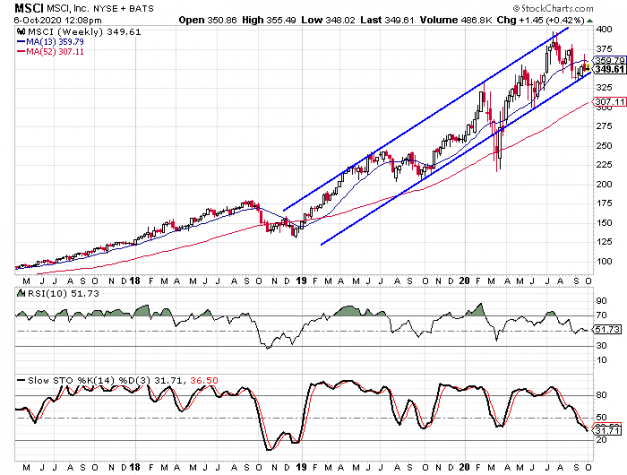With round lots of 100 shares becoming less important these days, we are seeing fewer stock splits it seems. There are a number of stocks that are trading above $200 a share and that is something we didn’t use to see very often — at least not when I first started studying the market, but that goes back awhile. It is easier to trade odd lots of stocks and even fractional shares these days.
The leverage provided by options can help investors control round lots of stock still and they can do so with far less of a cash outlay.
One stock that I really like that I have been watching for some time now is MSCI (MSCI). The company provides investment tools that help clients manage their investment processes. MSCI has partnered with iShares to provide a number of index oriented ETFs and you might see their name in that form from time to time.
The company has performed very well in recent years with earnings growing by 27% per year and revenue increasing by 10% over the same time period.
MSCI also boasts some impressive management efficiency measurements. The profit margin is 43%, the operating margin is 50.6%, and the return on assets is 13.5%.
As impressive as the fundamentals are, they only present half the picture.
Trending higher within a trend channel
Since the end of 2018, MSCI saw its stock rise over 200% through the high in July of this year. The stock moved from just below $132 a share to almost $400 a share in approximately 19 months.
A trend channel has formed that has helped define the various cycles within the overall upward trend and the stock is near the lower rail at this time.

We see that the stock dropped below the lower rail back in March, but it was only there for a few weeks and that was a black swan event where investors were panic selling almost everything.
If you look at the weekly stochastic indicators, the stock is the most oversold it has been since December ’18. The pullback since the July high has only been about 15%, but that was enough to move the stock from overbought territory to the lowest reading in almost two years.
The stock is trading right around $350 a share right now and that is where my discussion goes back to round lots. To buy 100 shares of the stock an investor would have to dole out $35,000.
Sure you could buy 10 shares for $3,500, but why not use options to control 100 shares with a much lower cash outlay?
With the stock trading at $348.17, the March ’21 330-strike calls are priced at $45.30, or $4,530. To buy 100 shares of the stock at the current price an investor would have to spend $34,817.
With the options you have the right to sell 100 shares of stock at $330 and you have spent 13% of what it would take to own 100 shares of the stock.
If the stock rallies by 15% from where it is now, it will be trading right at $400 and the options will be worth $70, or $7,000 each. That would also mean a gain of 55% on the options.
If the stock should fall below the $330 level and remain there until March 19 when these options expire, these options could expire at a 100% loss.
In that case, the investor would be out the full $4,530, but the stock investor would be out the same dollar amount if the stock drops by 13%. If the stock drops 20% from here, option investors would still be out $4,530, but stock investors would be looking at a loss of almost $7,000.
Yes, from a percentage standpoint the potential loss on the options is much greater. However, a decline over 13% will create a greater dollar loss for stock investors.


